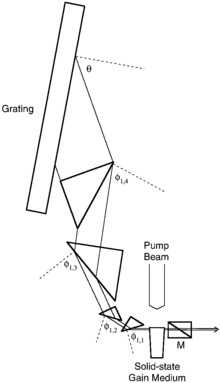A solid-state dye laser (SSDL) is a solid-state lasers in which the gain medium is a laser dye-doped organic matrix such as poly(methyl methacrylate) (PMMA), rather than a liquid solution of the dye. These lasers are also referred to as solid-state organic lasers and solid-state dye-doped polymer lasers.

SSDLs were introduced in 1967 by Soffer and McFarland.[2]
Organic gain media
In the 1990s, new forms of improved PMMA, such as modified PMMA, with high optical quality characteristics were introduced.[3] Gain media research for SSDL has been rather active in the 21st century, and various new dye-doped solid-state organic matrices have been discovered.[4] Notable among these new gain media are organic-inorganic dye-doped polymer-nanoparticle composites.[5][6][7] An additional form of organic-inorganic dye-doped solid-state laser gain media are the ORMOSILs.[7][8]
High performance solid-state dye laser oscillators
This improved gain medium was central to the demonstration of the first tunable narrow-linewidth solid-state dye laser oscillators, by Duarte,[8] which were later optimized to deliver pulse emission in the kW regime in nearly diffraction limited beams with single-longitudinal-mode laser linewidths of 

Distributed feedback and waveguide solid-state dye lasers
Additional developments in solid-state dye lasers were demonstrated with the introduction of distributed feedback laser designs in 1999[11][12] and distributed feedback waveguides in 2002.[13]